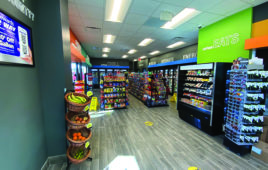Convenience stores are now majorplayers in the foodservice business. In a fewshort years, the industry has shattered many of the perception problems that marked its initial forayinto the food business and, if anything, it is driving thecharge toward convenient, fresher foods.
Chains like Sheetz, Nice N Easy, Wawa andQuikTrip are all among the innovators being targetedby companies such as Starbucks, McDonald's and Dunkin' Donuts. This is a radical change fromthe days when fast feeders owned a 60 to 70%foodservice market share.
Plus, the industry is driving speed of service andvalue without sacrificing quality. QuikTrip, for example,upgraded to a gourmet coffee program, but kept the price right where it was—still under $1 per cup.Starbucks can add all the hot sandwiches it wants toits breakfast menu, but it will still have a hard timecompeting with QuikTrip's brand recognition and value.
Sheetz and Wawa have virtually cornered themarket on speed of service and quality. Withcustomers using interactive kiosks, orders can be placed and prepared fresh in just a matter ofminutes, even during the busiest times. Combinedwith a competitive price, a product assortment tosatisfy consumers' fill-in grocery shopping needsand gasoline, these chains offer a one-stop shoppingexperience Ray Kroc never could have envisioned.
But it is hardly the big chains changing theindustry's perception alone. Small chains and single-storeowners are duplicating this success in localmarkets across the country, and the combined effortis having an enormous impact on the industry's overallshare of stomach dollars.
It is precisely this "success by design" that has convenience store owners excited about theirfoodservice future. The National Association ofConvenience Stores' 2007 State of the Industry (SOI)report helped quantify the industry's remarkablegrowth. Foodservice sales soared 5% last year to$18.8 billion with a gross margin percent of 49.8%.
Timing is Everything
The foodservice boost couldn't come at a bettertime. Credit card fees and high fuel prices are eroding profitability, but emerging trends within the foodcategory are helping sustain overall earnings. Trendsthat took flight in 2006 included commissary andpackaged sandwiches and healthy alternatives likefruits and vegetables in single-serve packs. Amongthe notable trends to watch in 2007 are sales oforganic and natural foods, cold and frozen dispensedbeverages and espresso-based coffees.
The bottom line for convenience store operators is that despite the concentrated marketing efforts ofsome national food chains to boost sagging volumes,the industry thrived, and it was no accident. But thereis considerably more work to be done to maintain thatmarket share.
A wise marketer once told me, "I may not be able to compete on price alone, but give me a goodlocation, a great staff and a quality product, and I can deliver customers the best value they're going to find." It took some time for customers to get thatmessage, but it now resonates across the entire retailcommunity. Now it's up to all of you to sustain it.
In this month's issue of CSD, we touch on thesalient points of building a foodservice businessfrom the all-important morning daypart to satisfyingthe growing "indulgence" snack occasions moreconsumers are treating themselves to in theafternoon and early evenings.
But a good product isn't enough. In this month'scover story (page 16), Warren Solochek, vice presidentof client development for NPD Foodworld, a division ofThe NPD Group, said retailers must have variety and agreat presentation as well.
Also in this issue, CSD examines some of theprocessing options chains are using to overcomeescalating credit card fees. According to the SOIreport, retailers were burned for an estimated $6.6billion dollars in credit card processing fees—anincrease of over $1 billion from the prior year. Butthere is some relief in sight. Tom Randolph, of TomRandolph Consulting, implored retailers to monitormonthly statements from Visa and MasterCard toreduce the number of "downgraded" transactions toqualify for the best interchange rates. Read MichaelFerrari's "Relief from Credit Card Costs" story here.




